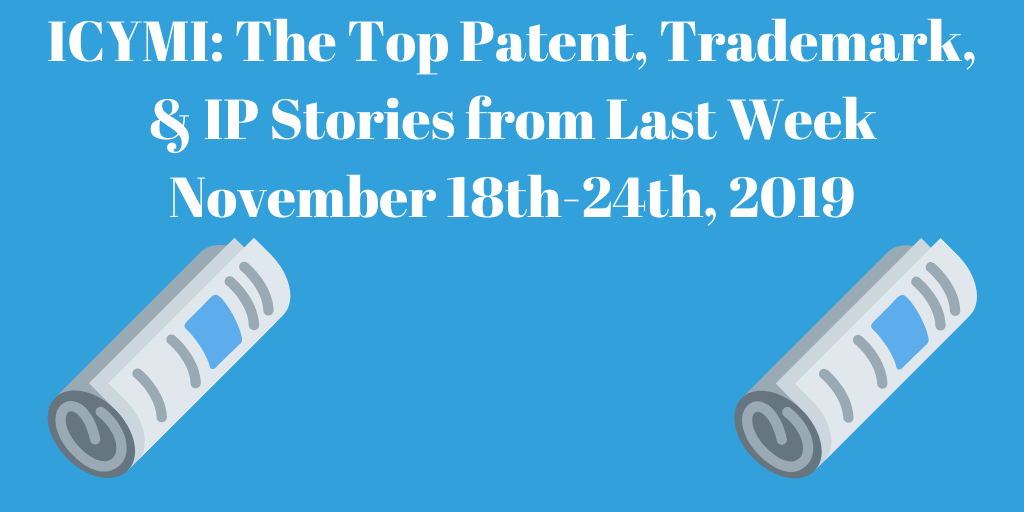Top Patent, Trademark, and IP Stories from Last Week (11/18-11/24/19)
Every week, we will be highlighting the top patent, copyright, trademark, intellectual property, etc. stories of the previous week in our “In Case You Missed It” segment. The list itself is in no particular order and includes a wide range of stories from the patent world that are informative, noteworthy, or just plain bizarre. The stories included encompass everything from Supreme Court cases to insights into growing industries. Please feel free to comment your thoughts on the stories or share an important one we missed!
“Here’s What the PlayStation 5’s Controller Might Look Like”
Gamers around the world have been waiting in angst for years for any details regarding Sony’s PlayStation 5 set for release November 2020. PlayStations are among the best selling video game consoles of all-time with the PlayStation 2 atop the list with 155 million units sold. Eager fans have spent the past 6 years since the PlayStation 4’s release speculating what the console and controllers for its successor will look like. There have been many rumors but a new patent filed in Japan by Sony shows what the controller could (possibly) look like.

Those waiting in angst may be disappointed however. It appears the (possible) PlayStation 5 controller is very similar to the current DualShock 4 controller. The analog sticks appear to be smaller and the L2/R2 triggers larger. Other features include the addition of a USB-C port and removal of the light bar. Sony’s CEO said last month that the controller would have greater “rumbling” effects in its haptic feedback and hinted at the possibility of a built-in microphone. This would make sense given we wrote about “Playstation Assist,” Sony’s attempt to offer voice-activated in-game assistance to players, in September. To read more about this story, click here (via The Verge, November 18th, 2019).
“Congress Introduces AM-FM Act to Revise Copyright Law for Terrestrial Radio”
Last week Congress introduced the “Ask Musicians for Music Act (AM-FM).” The effort is an attempt to make terrestrial AM/FM radio stations obtain permission before playing songs as well as pay royalties to music creators. Currently, radio stations do not have to pay royalties when songs are played on their airwaves. The bill would create a market for music and compensate artists based on market demand just like any other good and service.

Unsurprisingly the CEO of the Recording Industry Association of America (RIAA) Mitch Glazier applauded the measure. Glazier stated that it “addresses inequities in law that should be fixed” and that current procedures are “unjust and skews the market.” On the other hand, President and CEO of the National Association of Broadcasters said the bill could “decimate the economics of America’s hometown radio stations that have launched the careers of countless musicians and exposed legacy artists to a new generation of listeners.” It should be interesting how this plays out. The outcome could have huge implications to a terrestrial radio industry that has already been in the crosshairs of streaming services and podcasts. To read more about this story, click here (via Variety, November 21st, 2019).
“Drake’s Attempt to Trademark Canada’s Weed Warning Label Hits a Stop Sign”
Rapper Drake has attempted to trademark the warning label used on cannabis products sold in Canada with the USPTO. The warning label, seen here, contains both a marijuana leaf and the letters “THC” (abbreviation for tetrahydrocannabinol, the psychoactive ingredient in marijuana) on a red octagon, similar to a stop sign. Drake’s company Dream Crew IP filed the mark with intent to use on clothing including shirts, hoodies, hats, and sneakers. On November 21st, the application was rejected.
In the office action from the USPTO, the office identifies numerous reasons for rejection including the fact that “THC” is already trademarked and given the weight of “THC” on the mark, there may be a likelihood of confusion. The office also indicated that given the prominent use of the identical mark in Canada, as mandated under Canadian law, “the symbol will not be perceived as a mark that identifies the source of applicant’s goods.” Additionally, marijuana is still illegal on the federal level in the U.S. and “the use of a mark in commerce must be lawful.” Given Drake has partnered with a cannabis company in the past, he “did not have a bona fide intent to lawfully use the applied-for mark in commerce in connection with the goods,” according to the USPTO. To read more about this story, click here (via MarketWatch, November 23rd, 2019).
“Apple, Intel File Antitrust Case Against SoftBank-Backed Firm Over Patent Practices”
Apple and Intel filed an antitrust suit against Fortress Investment Group last week over allegations the group is using their patents to demand royalties from them. Intel had previously filed a suit against Fortress Investment Group last month but abandoned it to join Apple in their suit. Apple alleges the group has requested an upwards of $5.1 billion stemming from 25 different patent infringement suits filed against them.
Apple wrote in the suit that it has “suffered economic harm in the form of litigation costs and diversion of resources away from innovation to respond to these entities’ serial nuisance suits.” The company has a history of battles with “patent trolls” and this time is no different. To read more about this story, click here (via CNBC, November 20th, 2019).




